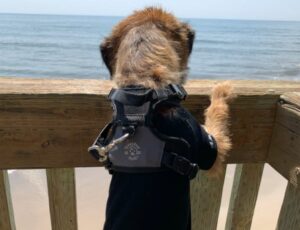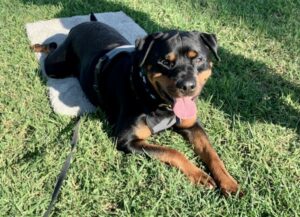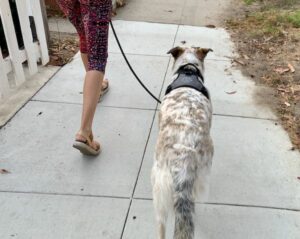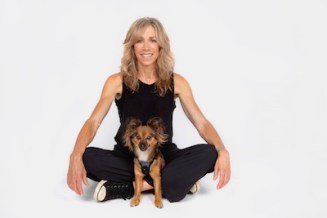Barks Blog
Dog Training in “3D”: Harnessing the Concepts of Distance, Duration and Distractions
By Joan Hunter Mayer of PPG corporate partner Transpaw Gear®

At TransPaw Gear, we want people to have adventures with dogs that are safe and fun. One way to help ensure that happens is by teaching dogs a few key skills. Concepts that apply to teaching and refining many different behaviors are the 3Ds: distance, duration and distractions.
Let’s look at each one in turn, including an example of how a versatile, well-fitting, force-free dog harness can help dogs and their humans achieve training successes together.
Distance
Distance, when applied to dog training, is exactly what you’d expect! How does the amount of space between, either the dog and the handler, or the dog and a distraction, affect the dog’s ability to execute a cued behavior? It may be easy for a dog to hold a stay, for example, when you’re standing right next to him, but if you step 5 or 10 feet away, it gets harder.
On the other hand, sometimes being closer to something can increase the difficulty of a behavior. For instance, when placing the food bowl or enrichment toy down on the ground for your dog to devour – the closer he or she is to the object, the more challenging it might be to focus on you and listen to cues.
Without the practice of gradually increasing the distance between handler and pup and/or gradually closing the gap between pup and a valued object, it’s unrealistic to expect dogs to respond reliably in real-life situations.
A key adventuring skill that is all about distance is practicing recall training. And this is where a harness with a sturdy handle can help. When recall exercises are going well, pet parents may begin to try to practice off leash in a secure area with few distractions (we’ll get to those shortly).
In this scenario, there are likely to be times when the dog isn’t on leash, but is wearing a harness. The harness’s handle can be a safe and convenient help if a situation arises where the guardian needs to keep the dog close at times during these training sessions.
Duration

Most of the things we ask dogs to do are behaviors that we would like them to start, and then keep doing. What good is a ‘sit’ if the dog pops right back up? Loose leash walking is a duration behavior too. Having your dog hang out by your side for a second, and then dart off to sniff a bush, is less desirable than a nice consistent loose leash.
Combined with skill in teaching leash manners, the right dog walking gear can help to make every outing a walk in the park! However, like distance, duration is something that needs to be built up slowly. It would be too much to expect 3 minutes of loose leash walking from a dog who has only ever done it for 3 seconds.
Dogs are excellent pattern-finders, and if their “job” just keeps getting harder and harder, they are more likely to check out and give up. This means that it’s best to vary the requested duration, with the average gradually increasing but the time itself going up and down.
For example, you could ask for loose leash walking in increments that look something like this: 3 seconds, 7 seconds, 2 seconds, 5 seconds, 10 seconds, 12 seconds, 8 seconds, 15 seconds, 5 seconds, 15 seconds, 20 seconds, 12 seconds, 18 seconds, 25 seconds, 5 seconds, 20 seconds, 30 seconds, etc. (This is not a hard and fast guideline! It’s just an example of how you might vary your duration.)
Distractions
It’s hard for your dog to focus on you when the world is so very interesting. We live in a distracting world, and it’s doubly so for dogs! We expect a lot of them – ignore that smell, don’t put that trash in your mouth, don’t bark back at that dog behind the fence. Distractions are everywhere, and so it’s important to gradually incorporate controlled distractions into your training.

Even for loose leash walking, it makes sense to start training in a quiet area inside the home, then move to a more distracting one, then take it outdoors to the least distracting part of the yard, then move it to the driveway, then the sidewalk in front of the house, then down the street, etc.
For a little extra assistance, consider a harness with two clip versatility. If a dog gets excitedly distracted on the leash and is pulling, switch the leash from the back D-ring to the chest D-ring.
Remember, when loose leash walking is rock solid on a boring, familiar sidewalk, that doesn’t automatically mean it’ll be the same during a brand-new hiking adventure. But it does mean that with practice and patience you may be able to work up to that slowly.
Self-control can be a limited resource, so do your best to be aware of the distractions around your dog at all times and adjust your expectations accordingly.
Key Points about Training in 3D:
-
- Go slow. Gradual change is a common theme when working on distance, duration and distractions. When dogs get stalled out in their training, perhaps the trainers or handlers have just upped the ante a bit too fast. Take a step back, make things easier, and try again.
- It’s hard to learn calculus while skydiving. In other words, if you’re making one of the 3D variables harder, it helps to make the others easier, or at least leave them the same. So if you’re adding distance to your recall, make sure the distraction level is lower than or comparable to what it has been. If you’re upping duration on your loose leash walking, do so in a less distracting area first. And if you’re working on harder distractions, don’t expect as much duration from your canine pupil.
- Harness the love. It’s easier (and kinder) to train dogs when they are comfortable and confident. A dog training and dog walking harness, designed for the love of dog, by a force-free trainer is one easy way to help make that possible.
Here’s to unleashing adventures and harnessing fun in all your dog training endeavors!

Listen to our BARKS Podcast with Joan Hunter Mayer of Transpaw Gear®
Related Posts
Empowering Dogs and Humans to Have a Deeper, More Connected Relationship – One Harness at a Time
How to Choose a Harness for Your Dog
About TransPaw Gear®


